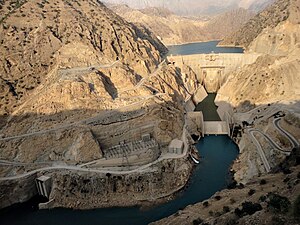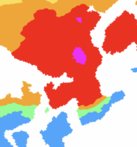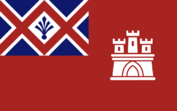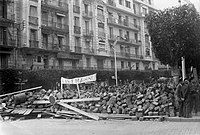Mekabiri
State of Mekabiri مکبیری (Ala) | |
|---|---|
| Motto: Somnium vita est Life is a dream | |
| Capital | Piri |
| Largest | Mi‘irabi |
| Recognised national languages |
|
| Recognised regional languages | |
| Ethnic groups |
|
| Religion | Juluvanism |
| Demonym(s) | Mekabirian |
| Government | Unitary presidential republic |
• President | Rahaēli Sērafīmi |
• Vice President | Richard Haller |
| Legislature | National Congress of Mekabiri |
| Càmara dos Senadores | |
| Càmara dos Deputados | |
| Independence from Orioni | |
• Independence | 1822 |
• Constitution | 1825 |
| Area | |
• | 522,586 km2 (201,772 sq mi) |
| Population | |
• 2022 estimate | 9,155,000 |
• 2020 census | 9,149,522[1] |
| Antipodes | Bexshaw, Eulycea, Oyussa |
| Driving side | right |
| Internet TLD | .me |
This article or section is in the process of an expansion or major restructuring. You are welcome to assist in its construction by editing it as well. If this article or section has not been edited in several days, please remove this template. If you are the editor who added this template and you are actively editing, please be sure to replace this template with {{in use}} during the active editing session. Click on the link for template parameters to use.
This article was last edited by Orioni (talk | contribs) 2 years ago. (Update timer) |
Mekabiri, officially the State of Mekabiri and internally known as Mek'abiri, is a sovereign state in Eastern Europa on Eurth. It is situated on the western shore of the Byzantine Sea and the northern shore of the Azure Sea. The country is bordered by Mahana to the north, Tamurin and Orioni in the east, and Miiros in the southwest. Piri is the capital and Mi‘irabi is the largest city; other major cities include Mazqabr and Mek’idesi. Mekabiri is approximately 522,586 km2 (201,772 sq mi) in size, without the territorial waters. The country is home to 9,149,522 inhabitants.
Mekabiri is a bicameral unitary presidential republic. The country's head of state is president Rahaēli Sērafīmi, supported by his Vice President Richard Haller. The territory that is now Mekabiri was first settled in prehistoric times. From the 14th century, it was a colony of Orioni until 1822 when the country gained its independence as a republic. Culturally, Mekabiri is still considered part of the Orinese diaspora.
The country's wealth comes largely from the industrial and tourism sectors, with limited contributions from fishing and services. International cooperation with Orioni represents a large share of the country's domestic product. Mekabiri is part of several international and intergovernmental institutions, including the Assembled Nations and Entente of Oriental States, as well as being a founding member of the Oriental Association for Regional Cooperation.
Etymology
The name of Mekabiri is an exonym, originating as the Oharic word Mek’abiri (መቃብር, "grave"). This name is a reference to the relative position of where the Sun sets or "goes to die" when viewed from Orioni.Other names have also been used, for example Mi'irabi ("west"), a term which applies to both Mekabiri and neighbouring Miiros. The frequent misspelling Merikebi ("ship" or "vessel") is a reference to the many ships that once sailed back and forth between Mekabiri and Orioni. Late Aroman historical sources have come to associate Mekabiri's hot and unforgiving climate with the macabre, a place described as "having the quality of having a grim or ghastly atmosphere".[citation needed]
WIP. During the colonial period (1349-1822) the country was called Birlini.
- At first there only existed a city on the coast. Locals were instructed to bring resources to a warehouse called Perlinin, for transport to Orioni.
- The warehouse would become a city, and later the capital of Mekabiri. Non-Orinese use the country name, while people from Orioni use
- Birlini, a reference to the entire country by its capital city name (a pars pro toto.
- Per•li•nin (Ancient Oharic: house tribe lady), or roughly the house of the land of the lady.[2]
- Oharic is widely spoken as a first language by millions in the coastal cities. However, Oharic becomes more of a lingua aromana among the rural and interior populations, where a variety of Shakyan languages are spoken as a first language. Mekabiri is generally known as "Dižgang" by the Shakyan people.
Geography

WIP
- Landscape. Mekabiri is characterised by its mountains and dry climate, and its lack of major rivers. There are many small forests along the southern coast, whose trees grow big and strong because of the rich soil.[3]
- Climate
- Southern coast is habitable. Rest is desert.
- Northern highland Bidakiye (Mahanan: Upatyakā, "valley").
- Capital at an estuary, in a well-defensible position.
- On the Piriwadi River. Make the city a bit more westward into that temperate zone, so the river placement makes sense.
- Natural harbour?
- Ancient dock of the Pearl Road?
- Keep Emakera as a border province. Influence from nearby authoritarian Mantella, who attempted to detach this territory from Mekabiri by emphasising the north-south differences and exploit cultural differences.
History
Pre-colonial period
- Early population came from Azania and Amutia in the west. The land used to be much greener, with more trees and grass. But after the last ice age ended, the climate became warmer and desertification increased.
- Prehistory: The changing climate led to more diversity in fauna and flora. And the early human cultures were also affected: fishermen along the coast, herders in the highlands, nomads in the desert.
- 1000-0 BCE: Small pockets of agriculture in some rare river valleys, mostly occupied with subsistence farming.
- 0-500s CE: The coastal area becomes tied into the Pearl Road. The peninsula is a crossroads for many other historic nations. Shakyan people begin their invasion and settle en masse in Mekabiri.
- 500-1000s: Various Shakyan kingdoms and republics vie for hegemony. The pacifist Sokhainean people are attacked and pushed off the mainland by a coalition of rival kingdoms. Borderland against the Sacred Aroman Realm, separated by the large desert are.
- 1000-1400s: This can be a golden age. Early, high, late. Maybe influence by Mahana. The late age weakens Mekabiri, allowing for easier Orinese conquest.
Colonial period
- 1349-1822: Official colonial period of Birlini. To be tied into the Orinese colonial expansion.
- 1300s: Area gives Orioni control of the Menelassar Bay.
- 1400s: Mostly extraction economy. First forts along the coast. Later on, more defensive lines inland.
- 1500s: As trade prospered, the rich southern territories needed to be defended against indigenous horseback raiders from the north. These raiders attacked small settlements and got away with stolen cattle. The Orinese Danya Boyi Kiburi ina Tewagi (1477-1529) employed local labour to build a 250-kilometres-long defensive system across the central part of Mekabiri. This includes three-meter-wide trenches, reinforced with wooden watchtowers, small strongholds, and garrisons. After the 1700s, when it could no longer stop large-scale incursions, the system fell in disrepair. Traces of the earthworks called The Lost Scars of Boyi can still be seen in the landscape.
- 1700s: This is when the Orinese conquered the northern parts up to Mahana. As a compromise to established peace, a Mahanan noble was appointed to rule the border provinces, while being subjected to the Orinese sovereign. These nobles grew ever more independent.
- 1800s: In the early 19th century, Mekabiri was ruled by the Mahanan Sanjay Sherchan. Nominally, he was still an Orinese vassal. But in reality he acted as a sovereign in his own right. Sherchan dictated his own foreign policy and only listened to the Empress when he felt like it. After a brutal, decade-long war which involved foreign support and intervention, the Mekabirians freed themselves.
- Colonial flag with a tower refers to the typical colonial-era forts along the coast. These could also be further inland. From a strategic point of view, there need to be at least two "choke points" along each side of the northern mountain range.
Independence
- Events leading up to the 1822 revolution. Mekabiri was part of the first wave of Orinese decolonisation, together with Tamurin (1781), Baribeni (1843) and Tahini (1847). Tamurin was the first domino to fall. A later, second wave of Orinese decolonisation occurred in the 1900s: Astrini (1901), Daini (1908), Rohini (1949), Burkini (1955), and Thubani (1969).
- 1800s: End of monarchy. (See: the end of Peter I in Emakera.)
- Re-use later history from Pirilao and Emakera.
20th and 21st centuries
- 1900s: Republicanism.
- 1932-1956: Long War.
- 1954: Europan Commercial Alliance founded.
- 1957: Assembled Nations founded.
- 1970s: Large construction projects. (See: the construction of Paço in Emakera.)
- 2006: Co-founded the Entente of Oriental States.
- 2016: Co-founded the Oriental Association for Regional Cooperation.[4]
Politics
Government
Mekabiri is a unitary presidential republic with a multi-party political system. The country is divided into 7 provinces and the Capital district. These administrative divisions were updated several times since independence. There is a clear separation of powers. Executive power is exercised by the government of President Rahaēli Sērafīmi, the country's head of state, supported by his Vice President Richard Haller. Legislative power is vested in the bicameral National Congress. The Càmara dos Deputados has 100 members, directly elected by the people, which makes law projects and propositions. The Càmara dos Senadores has 100 members, also elected by the people, which vote for or against the law projects made by the Deputados.[8]
Foreign relations
Mekabiri is a member of the Assembled Nations, the Entente of Oriental States, and previously also the Europan Commercial Alliance. The military unpredictability of Mantella is widely considered as the biggest wildcard in Amutian politics. As the peace process drags on, EOS has implied the possibility of a pre-emptive intervention.[citation needed] If it does happen, it will be the most significant regional event in Amutia in recent years. The Mekabirian armed forces not prepared to deal with the downstream consequences of such a development. The AN maintains a small observer force along the northwestern border, where numerous Mekabirian troops are stationed.
Military
The military of Mekabiri consists of the Mebakirian National Army (MNP), the Mebakiri National Navy (MNN), and the Mebakiri Air Force (MAF). Military service is compulsory for men aged 19–29, for a total of 10 months. The Army includes two armoured and two mechanised divisions. Mekabiri also recruit large amounts of the skilled Durkha warriors of Mahana, the Mekabiri Army Durkhas. Most of Mekabiri's weapons are imported from Miiros. Mekabiri operates a "green-water navy" (near to shore) that is capable of operating in the littoral zone. The navy is primarily focused on securing its exclusive economic zone. The Mekabirian air force formed in 1963. Many pilots train in friendly countries such as Tamurin.
Economy

WIP
- Looking into the economy of RL Morocco, which is also a mostly coastal country with a dry hinterland.
- Exports.
- Currency. Want to use the Orinese Phi, but might also go with Miiros just to snub the old coloniser.
- Employment. Might opt for Moroccan unemployment numbers, so as no to overpower any neighbours.
- Energy.
- Transport.
- Media.
Demographics
WIP
- Mekabiri's population consists mostly of Orinese settlers and native peoples, the Emakeran being the most known of them. Since intermarriage between the settlers and the natives is very usual in Emakera, most of the people have mixed ancestry in some degree. Everyone born in the country is treated as Mekabirian, independent of heritage. Racism is a unbailable crime.[3]
- Religion. Mekabiri is a secular state. Juluvanism is the most dominant religion, Orinese faiths (15%), Salam (5%), Other Faiths (3%), No religion (2%).[8]
- Health.
- Education.
- Mixture of Pirilao and Emakera. Adopt culture from both. Previously, these two separate countries. But now they are a mixture of both. This forced colocation purposely undermines Mekabiri's internal stability. This is comparable to how Iraq was constructed out of 3 large, competing groups.
- Continue to build a shared lore with Mahana.
Cultures
WIP
- Literature.
- Visual arts.
- Music.
- Cuisine.
- Sport.
References
- ↑ OOC. The population number is the calculated average of Emakera and Pirilao.
- ↑ OOC. "Per" means "house" as seen in Ophir, which I use as an ancient lost city. "Li" is reversed "il" re-used from Ilkhan (title), which should be understandable to the Shakyan natives. "Nin" is already part of the etymology of Orioni, so probably distinct enough to be associated with Orioni.
- ↑ 3.0 3.1 NSwiki: Emakera (15 January 2006)
- ↑ OARC 2022 Meeting (20 March 2022)
- ↑ OOC. Reference to the player behind the retired country of Pirilao.
- ↑ OOC. Reference to the player behind the retired country of Emakera.
- ↑ OOC. The word megoteti (Oharic: protrusion) comes from the original meaning of ziggurat (Semitic: protrude). The image itself is the Al Zaqura Building in Baghdad, Iraq.
- ↑ 8.0 8.1 The Federative Popular Republic of Emakera (13 January 2006)
- ↑ OOC. Based on the Yardna River and Karun-3 Dam.















